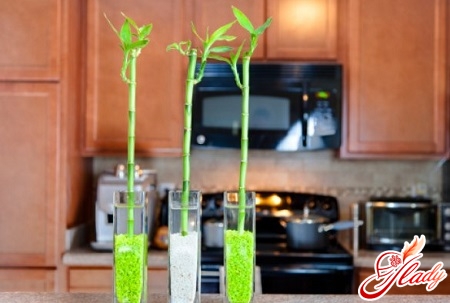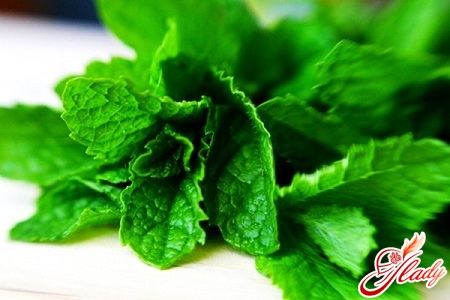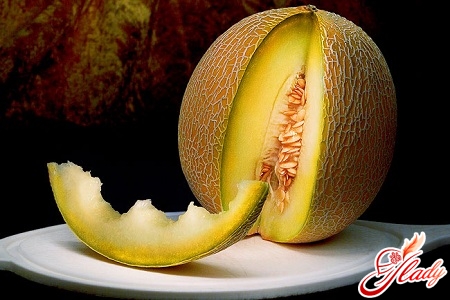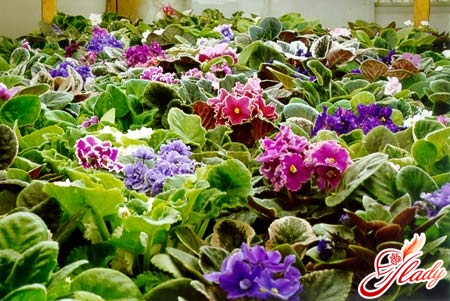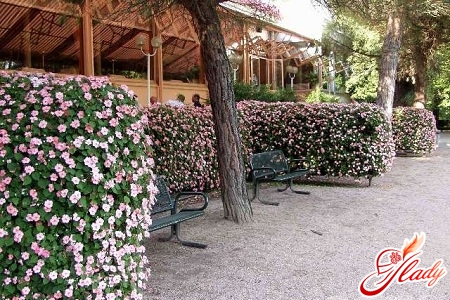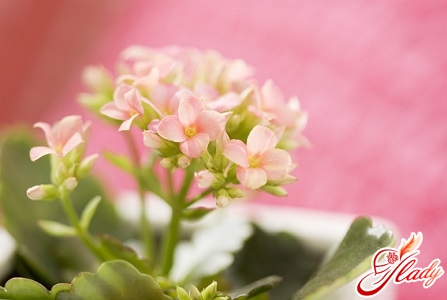 Kalanchoe is associated with a boringan ordinary-looking flower on the windowsill, which is grown exclusively for medicinal purposes. Of course, Kalanchoe has healing properties. However, not everyone knows that there are varieties of very decorative, abundant and often flowering Kalanchoe. The flowering of the Kalanchoe is a surprisingly colorful and eye-pleasing period. Lovers who bought or received a bouquet as a gift often do not know what to do with it after flowering and what care the plant needs. It is not so easy to make a Kalanchoe flower again! However, there are their secrets of agricultural technology, as well as the rules of plant care, which allow the Kalanchoe to bloom again and again, every season pleasing the hosts with new bouquets. When and under what conditions the Kalanchoe blossoms, how to care for it and how to make it bloom repeatedly, we will try to find out.
Kalanchoe is associated with a boringan ordinary-looking flower on the windowsill, which is grown exclusively for medicinal purposes. Of course, Kalanchoe has healing properties. However, not everyone knows that there are varieties of very decorative, abundant and often flowering Kalanchoe. The flowering of the Kalanchoe is a surprisingly colorful and eye-pleasing period. Lovers who bought or received a bouquet as a gift often do not know what to do with it after flowering and what care the plant needs. It is not so easy to make a Kalanchoe flower again! However, there are their secrets of agricultural technology, as well as the rules of plant care, which allow the Kalanchoe to bloom again and again, every season pleasing the hosts with new bouquets. When and under what conditions the Kalanchoe blossoms, how to care for it and how to make it bloom repeatedly, we will try to find out.
Types and varieties of flowering Kalanchoe
Not all species of Kalanchoe differdecorative. However, flowering varieties have one very attractive feature for florists - they bloom in the cold season. Note that the species of Kalanchoe is the result of natural "selection". That is, all kinds of Kalanchoe can be found in the wild. But various decorative varieties of this plant were excreted by humans. So different types of Kalanchoe in indoor floriculture are represented by numerous varieties. And if you decide to have a blossoming copy of this medicinal succulent, then you should pay attention to the following varieties. Kalanchoe Blossfelda A species that grows in the shady forests of the island of Madagascar. A plant of medium height with a strongly branching crown, oblong green leaves with a red border. On sale you can find such varieties of Kalanchoe Blossfeld, differing in the coloring of flowers:
- Goldstrike, Alexandra, Ingrid, Karen, Foundation - varieties with yellow flowers;
- Amora, Kavi, Fuego, Kerr, Marie, Cassandra - varieties with red flowers;
- Bardot, Arina, Nadia 2000, Carmen, Naomi - varieties with orange flowers;
- Miya, Elsa, Pluto, Simone 2000, Cora White - varieties with white flowers;
- Avalon, Delia, Gwenn, Dion, Cora, Katerina, Melanie - varieties with pink flowers.
Kalanchoe Kalandhoea Species of KalanchoeBlossfeld, which is more compact in size, large flowers with double petals. A species that is maximally adapted to growing at home. The common varieties Kalanchoe Kalandiva:
- Calandiva Cher, Calandiva La Douce, Calandiva Dion - varieties with pink flowers;
- Calandiva Hayworth, Rosalina Don Juan, Calandiva Taylor, Calandiva Kerr - varieties with red flowers;
- Calandiva Bardot, Rosalina Don Domingo, Rosalina Don Frederico, Calandiva Fonda - orange and yellow flowers;
- Calandiva Monroe, Rosalina Don Leon - white varieties.
Kalanchoe Bechar Large plant that reachestwo-meter height. It is distinguished by its decorative features even in the absence of flowers - it has large wedge-shaped leaves with a serrated margin and a waxy coating of grayish color, pubescent with thin brown hairs. Blooms abundantly and continuously collected in panicles yellowish flowers with longitudinal purple stripes. Peduncles reach a height of up to thirty centimeters. Calanchoe aloca and Kalanchoe Tessa Species that differ in hanging flowers. At Kalanchoe Tessa flowers of peach or pink color have the form of a bell and hang down on thin stems. Kalanchoe alochachechnoe will please you with hanging flowers of orange or red color and oblong form. Both species are suitable for keeping in bright rooms, and the Kalanchoe Tessa is grown and hydroponically (without soil mixture). 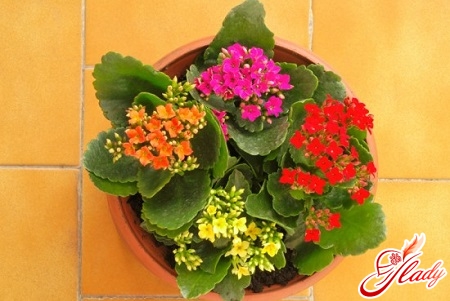
Caring for a flowering Kalanchoe
The flowering period is the maximum timeactivity of a plant. Therefore at this time he needs maximum care and attention. How to care for a Kalanchoe during flowering? Kalanchoe refers to light-loving houseplants and perfectly tolerates even the scorching sun. The period of flowering begins in this plant in the autumn-winter time, so it is necessary to try to provide a blooming Kalanchoe with a well-lit location. The best place for a flowering Kalanchoe will be the southern window sill. With a lack of light, the leaves of the plant turn pale, the stems stretch, and the flowers fall. However, too high a temperature Kalanchoe suffers with difficulty. Therefore, in the hottest time of the day it should be moved away from the window heated by the sun. To humidity in the room Kalanchoe undemanding - this is succulent. Therefore, in frequent spraying, this plant does not need. It is enough only to wipe his leaves from time to time with a damp cloth, removing dust. And if you are spraying the plant during flowering, then try not to moisten the flower itself, but only the air near it. It is best to grow and bloom these green pets at a moderate temperature. And the most suitable temperature for him is from eighteen to twenty-eight degrees of heat. If the room is very hot, the plant will start to drop flowers, and the leaves will turn yellow, dry and fall off. For the same reason, the flower should be protected from streams of dry and hot air and do not put a pot of Kalanchoe near heating batteries and heating appliances. But the most important thing is to properly water the Kalanchoe. This should be done as the earth coma dries up, and in no case should there be any waterlogging or drying of the soil in the pot. To water the Kalanchoe it is necessary only with soft well-settled water, and after watering dry the bottom of the pot and the pan. During the flowering season, Kalanchoe is fed not more often than once a month, using complex fertilizers or preparations intended for flowering houseplants. After flowering, the plant has a rest period. It is the proper care for him at this time that will help the Kalanchoe bloom repeatedly. 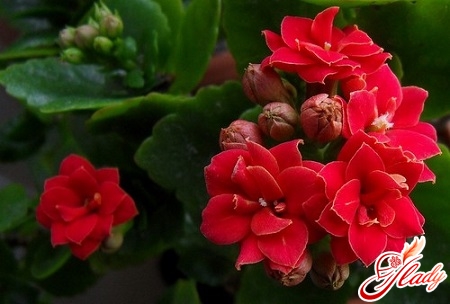
Period of rest and preparation for flowering
How to make the Kalanchoe bloom in the new season? As we already said, there are small secrets that help to achieve a second flowering. But in addition to these secrets, you need to know how to care for the flower in the rest period. After the flowering period should immediately cut the plant on the stump. That is, remove all stalks and peduncles from it, leaving no more than three centimeters of shoots above the ground. The pot with the flower is taken to a shady place and left almost without watering for a month and a half. It is important that at this time the flower is in a cool room, where the temperature does not rise above fifteen degrees of heat. In this case, the plant should never be stored in the refrigerator! After one and a half months of almost complete rest, the Kalanchoe begins to awaken and prepare for flowering. At this time, it must be moved to a well-lit warm room and resume traditional care. From the end of spring and until mid-summer, the Kalanchoe must be fertilized, fed a couple of times a month. For fertilizing it is possible to use complex fertilizers for flowering plants or fertilizers intended for succulents and cacti. When the flower again starts growing, all the new shoots are plucked, and the stalks with the leaves growing at the site of the cut are also pricked at the height of the third pair of leaves. This will form a thick crown of the bush and will not allow the stems to stretch. The last time the calanchoe is plucked about in November, and after that the time comes when the proper care of the plant will help make it bloom. The fact is that Kalanchoe refers to plants that blossom only with a short light day. If you provide a Kalanchoe with a light day lasting no more than eight hours, then you can make the plant bloom on time. So care for the flower during this period remains the same - watering, maintaining a comfortable temperature, wiping leaves from dust, periodic moistening of the air around the plant. But here the light day needs to be reduced. To do this, in the light it needs to be kept no more than eight hours a day. After that, the flower must be removed to a dark place or covered with an opaque cap (for example, cardboard), which must cover both the plant itself and the flower pot. In the morning, the hood is removed and access to the flower is provided for eight hours. After a month of such manipulations, buds will appear on the Kalanchoe. After that, you can no longer cover it with a hood - consider that you can make the plant bloom! So, the right care and competently seasoned rest period is the guarantee that the flowering of the Kalanchoe will resume with the onset of the new season. But how to care for him, you already know. It remains that? It remains only to translate their knowledge into practice, providing the flower with competent care. Dare! And you will succeed!




